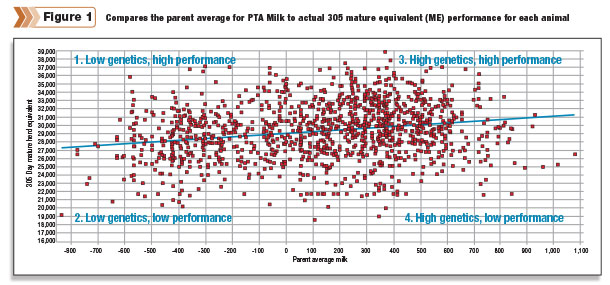Creating extra heifers provides you many intriguing options – the option to expand, the option to sell extra heifers and the option to sell your low-producing cows.
While these options all have the potential to propel herd improvement or provide added profit, there are some caveats to consider before you decide to create extra heifers for your dairy.
1. Do you have room for the extra heifers?
If your facilities become severely overcrowded because of the extra heifers you create, you may not yield optimal heifer performance.
2. Will female calves be worth more than male calves in nine months?
If females are not worth more than males, then you should consider whether creating more of a less valuable gender even makes sense.
The fact is: In recent months, Holstein bull calves have been worth more than female calves in most parts of the country. While that situation is different for Jerseys, both Holstein and Jersey producers creating more animals than needed to maintain their herd size have the option to make a terminal beef cross. This yields a more valuable calf, regardless of the calf’s gender.
3. What will you do with the extra females?
If you are going to expand, these aren’t truly “extra” heifers but future members of your milking herd. If you are creating extra females with the intent of selling them, be sure to evaluate the price risk between the time you create them and the time you sell them.
Decisions to make
High pregnancy rates, optimal calf care programs, earlier ages at first calving and more sexed semen use have created a surplus of female calves and heifers for many dairy producers.
Suppose you are one of those producers who has extra females right now – more replacements than you would generally “need” to maintain your herd size. Should you sell them before they calve?
If you decide selling extra heifers is the best choice, one option is to sell the animals with the least genetic potential – which you would identify through parent averages or genomic testing. A second option is to sell those heifers that grew slower, got sick more often or took more services to become pregnant.
Even though both options to select which heifers to sell are positively correlated with future performance, they are only predictions. In other words, on average as a group, the heifers that grow the slowest will indeed be less productive cows than the heifers that grow well.
Likewise, the group of heifers with the least favorable genetics will certainly produce less than the group with the best genetics.
However, these factors are not perfect predictors. Therefore, if you choose to make a culling decision based on one of these predictions, mistakes will be made. You’ll end up culling heifers that would have performed better than others you decided to keep.
A real example
Take, for example, the scatterplot in Figure 1, with each red dot representing one first-lactation animal. This compares the parent average for PTA Milk to actual 305 mature equivalent (ME) performance for each animal. You can see a general trend that animals bred to produce more milk will produce more milk.
 Genomic testing does make the genetic prediction (represented by the blue line in Figure 1) more accurate. But despite this accuracy, genetics are still not a perfect predictor of actual performance for an individual animal.
Genomic testing does make the genetic prediction (represented by the blue line in Figure 1) more accurate. But despite this accuracy, genetics are still not a perfect predictor of actual performance for an individual animal.
Therefore, a potential missed opportunity comes if you would have decided to cull any of these individual first-lactation animals before they ever freshened, based only on their genetics.
If milk production is your main selection goal, and you sold the lowest heifers for predicted milk production, you would have decided to sell the heifers that appear on the left of the figure.
You can see that most of those animals have below-average milk production (appearing below the line), and some individuals produced well above average for the herd.
Yet you wouldn’t have known with certainty how these animals would perform before they got a chance to prove themselves. Genetic predictions work extremely well across large groups of animals but are not a perfect predictor of an individual animal’s performance.
There are so many environmental challenges a cow may experience. She may have a difficult calving, get a sore foot or get mastitis. Any of these factors will have an effect on her overall performance and is likely completely separate from her genetic potential.
No perfect predictors
If we translate this in terms of baseball and have to predict which player is going to go 4 for 4 in tonight’s game, we would probably pick the one with the highest batting average, or perhaps the highest batting average against that particular pitcher. While having that information increases our odds of being correct, our prediction is certainly not perfect.
However, tomorrow morning, we will know exactly which player went 4 for 4 – and it might be the guy that had been hitting just .200.
The same is true in cows. Even though we can get close to knowing which animals will perform best based on their genetics, no predictors are perfect indicators of future performance. Like Figure 1 shows, sometimes a cow outproduces her predictions, and sometimes she performs less than expected.
Culling heifers with the poorest growth rates or least desirable genetics is always an option to consider if you do not have the space to raise those heifers.
But it’s important to recognize that when you cull a heifer, you essentially cash in all your options. You ultimately lose your ability to cull a less efficient cow at the time when that heifer would have entered the milking string.
While we can make predictions of future performance before an animal ever freshens, our predictions are rarely perfect indicators of future performance.
Keeping extra heifers gives you the option of culling the cows that actually perform the worst, instead of the heifers you predicted would end up as the worst-performing cows. PD

-
Nate Zwald
- U.S. Sales Manager
- Alta Genetics
- Email Nate Zwald






